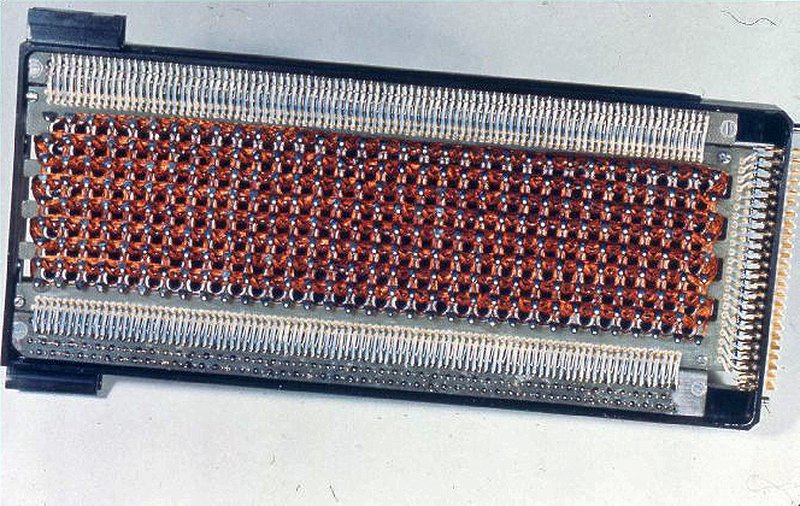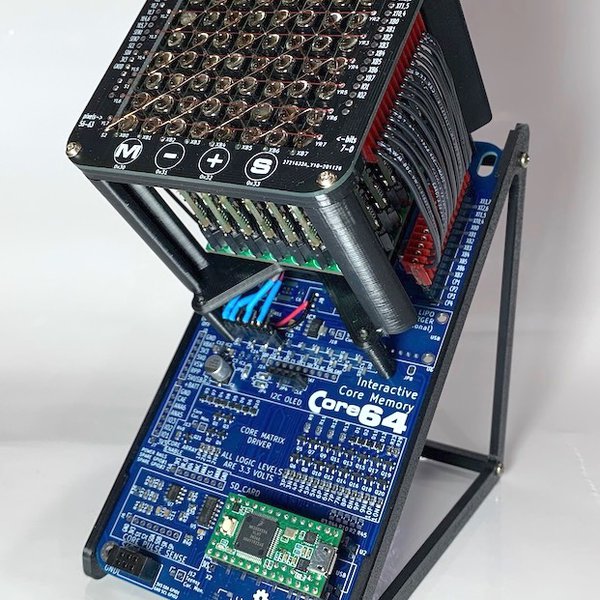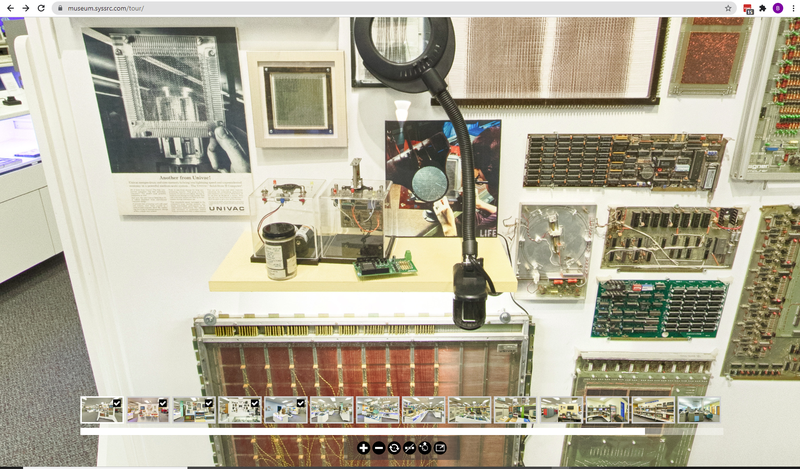 OK folks, let's start it up. Welcome to the Hack Chat, I'm Dan and I'll be moderating along with Dusan as we welcome Andy Geppert to talk about retro memory technologies.
OK folks, let's start it up. Welcome to the Hack Chat, I'm Dan and I'll be moderating along with Dusan as we welcome Andy Geppert to talk about retro memory technologies.
Welcome Andy! Can you start us off with a little about how you got interested in this stuff?
 better than the old 9 and something
better than the old 9 and something
 Hi Dan, Andy!
Hi Dan, Andy!
 Howdy Dan and Andy!
Howdy Dan and Andy!
 Hi everyone! I appreciate the opportunity from Dan to be a Hack Chat host on the topic of retro memory! I enjoy design and building electromechanical stuff. In the last several years I have gotten into retro computing and some of the technologies that are intertwined with retro computing. I think core memory is fascinating and that extends to pretty much anything involving magnets. Three years ago, I was looking for a way to explore core memory in a more tangible way, and I found it with my interactive core memory project. It’s been a lot of fun to learn, experiment, and design something that others will have an opportunity to enjoy. That project was substantially inspired and encouraged by people in the Hackaday community. I’m guessing a few of you supportive folks are here in the crowd! My dive into core memory has also opened up learning opportunities around all sorts of other kinds of memory that I didn’t know about (like FeRAM or FRAM). I look forward to learning more as we chat away on these topics. Feel free to share any of your retro memory experiences you have.
Hi everyone! I appreciate the opportunity from Dan to be a Hack Chat host on the topic of retro memory! I enjoy design and building electromechanical stuff. In the last several years I have gotten into retro computing and some of the technologies that are intertwined with retro computing. I think core memory is fascinating and that extends to pretty much anything involving magnets. Three years ago, I was looking for a way to explore core memory in a more tangible way, and I found it with my interactive core memory project. It’s been a lot of fun to learn, experiment, and design something that others will have an opportunity to enjoy. That project was substantially inspired and encouraged by people in the Hackaday community. I’m guessing a few of you supportive folks are here in the crowd! My dive into core memory has also opened up learning opportunities around all sorts of other kinds of memory that I didn’t know about (like FeRAM or FRAM). I look forward to learning more as we chat away on these topics. Feel free to share any of your retro memory experiences you have.
![]() I am interested in building a way to visualize delay line memory for our museum visitors
I am interested in building a way to visualize delay line memory for our museum visitors
 Regrading floppies, still made, I can't find it... but I thought I read an article on Hackaday recently about a place in North Dakota still making the media?
Regrading floppies, still made, I can't find it... but I thought I read an article on Hackaday recently about a place in North Dakota still making the media?
 oh interesting thanks, will try googling north dakota too then
oh interesting thanks, will try googling north dakota too then
 Hi Andy, thanks for hosting this chat. Your work with core memory is beautiful!
Hi Andy, thanks for hosting this chat. Your work with core memory is beautiful!
 In case you missed it:
In case you missed it:

https://hackaday.io/project/166155-core-64-interactive-core-memory-badge
Core 64: Interactive Core Memory Badge
Draw with a magnet directly IN CORE MEMORY! Many people may have heard of core memory (most recently with the buzz surrounding the Apollo Guidance Computer) but few have experienced it. This project enables interaction and education using core memory that is unexpectedly engaging with the door wide open for more exploration.
 Do you know of anyone (or have any ideas) for visualizing the electromagnetic patterns in core memory? Especially video would be really cool -- to observe how the electromagnetic field changes?
Do you know of anyone (or have any ideas) for visualizing the electromagnetic patterns in core memory? Especially video would be really cool -- to observe how the electromagnetic field changes?
 @broswell That's good project to ponder! This might inspire you, as it did me: https://hackaday.com/2014/01/07/acoustic-delay-line-memory/
@broswell That's good project to ponder! This might inspire you, as it did me: https://hackaday.com/2014/01/07/acoustic-delay-line-memory/
![]() Thanks. I'll take a look
Thanks. I'll take a look
 @Kelly Heaton Thank you! I would have never guessed I'd be weaving electronics in my middle-age years. ;)
@Kelly Heaton Thank you! I would have never guessed I'd be weaving electronics in my middle-age years. ;)
 My guess is that you *could* do it with some iron filings, but I doubt you'd *want" to do it that way
My guess is that you *could* do it with some iron filings, but I doubt you'd *want" to do it that way
 Have you seen the piezo delay lines they used to use in TV apparently on a sheet of quartz i think
Have you seen the piezo delay lines they used to use in TV apparently on a sheet of quartz i think
 I have many TV delay lines - never wirred them up yet!
I have many TV delay lines - never wirred them up yet!
 How hard is it to get all the currents right? I've always been put off by the 'half doesn't do anything, but double it and it flips'? That seems really tight to me. I'd love to build core but am frighted by the tollarances.
How hard is it to get all the currents right? I've always been put off by the 'half doesn't do anything, but double it and it flips'? That seems really tight to me. I'd love to build core but am frighted by the tollarances.
 Hi Andy! I'm not sure if you've seen Jerry Walker's videos, but he had a series on core memory recently. In his series he mentioned that core memory needs to use very specific ferrite cores, otherwise it doesn't quite work right. Have you tried experimenting with different types of cores to see if you can get them to work?
Hi Andy! I'm not sure if you've seen Jerry Walker's videos, but he had a series on core memory recently. In his series he mentioned that core memory needs to use very specific ferrite cores, otherwise it doesn't quite work right. Have you tried experimenting with different types of cores to see if you can get them to work?
 @Andy Geppert You should have a look at the work of Robin Kang. She weaves beautiful giant PCB inspired art
@Andy Geppert You should have a look at the work of Robin Kang. She weaves beautiful giant PCB inspired art
 @Kelly Heaton I think scaling up to larger cores would make a visualization like @Dan Maloney suggests a possibility. One thing I'd like to do is scale up my project to bigger cores (1/2" ?) and more current, so we could see the core jump when magnetized. That'd make a fun exhibit.
@Kelly Heaton I think scaling up to larger cores would make a visualization like @Dan Maloney suggests a possibility. One thing I'd like to do is scale up my project to bigger cores (1/2" ?) and more current, so we could see the core jump when magnetized. That'd make a fun exhibit.
![]()
 Coming from an RF electronics POV, there's a lot of mystique about ferrite formulations, so I can imagine getting the mix just right for core memory must be a challenge
Coming from an RF electronics POV, there's a lot of mystique about ferrite formulations, so I can imagine getting the mix just right for core memory must be a challenge
 interesting, the cores move noticably then? maybe you could put a big fresnel type lens system in front?
interesting, the cores move noticably then? maybe you could put a big fresnel type lens system in front?
 @Andy Geppert does it realy jump? Can you see the change in position when they stop?
@Andy Geppert does it realy jump? Can you see the change in position when they stop?
![]() Here is a picture of part of our memory display. Hard to see, but we have a little one bit demonstrator.
Here is a picture of part of our memory display. Hard to see, but we have a little one bit demonstrator.
 @anfractuosity TV Delay lines is a whole new topic to me. I'm not familiar with that.
@anfractuosity TV Delay lines is a whole new topic to me. I'm not familiar with that.
 you can get them pretty cheaply from ebay, i need to play with the few i bought
you can get them pretty cheaply from ebay, i need to play with the few i bought
 I imagine the cores act like any motor -- current induced by the magnetism would pull on the whole assembly and make it want to move. Never though about my power drill having simple memory...
I imagine the cores act like any motor -- current induced by the magnetism would pull on the whole assembly and make it want to move. Never though about my power drill having simple memory...
 ( they look like this , if you haven't seen them - https://www.flickr.com/photos/anachrocomputer/2839532023 )
( they look like this , if you haven't seen them - https://www.flickr.com/photos/anachrocomputer/2839532023 )
 @broswell where is your display located?
@broswell where is your display located?
 If you made a core memory with big ferrites and put one of those tiny compasses on top of each cell, that might work too.
If you made a core memory with big ferrites and put one of those tiny compasses on top of each cell, that might work too.
 @Dan Maloney that's a great idea!
@Dan Maloney that's a great idea!
 @Tony Robinson The currents aren't that difficult to get working, in my limited experience. About 250mA per wire (give or take 20% at least) works for the cores I use. This seems like a good match to what I'm using:
@Tony Robinson The currents aren't that difficult to get working, in my limited experience. About 250mA per wire (give or take 20% at least) works for the cores I use. This seems like a good match to what I'm using: 
 What kind of frequency can you change the 'state' of the cores? i just thought you could maybe also 'listen' to them using a radio
What kind of frequency can you change the 'state' of the cores? i just thought you could maybe also 'listen' to them using a radio
![]() System Source Computer Museum, Hunt Valley (Suburban Baltimore) Maryland.
System Source Computer Museum, Hunt Valley (Suburban Baltimore) Maryland.
![]()
SYSSRC BOB ROSWELL
System Source Computer Museum
System Source Computer Museum
 @anfractuosity it would be super cool to listen to memory
@anfractuosity it would be super cool to listen to memory
 @Tony Robinson I have not see the cores move, but I know wires alone will jump at higher currents (spot welder!). And I was told by someone who work on core memory back in the day, that one should avoid writing the same polarity repeatedly/fast, because the core will start to spin, and cut the wires. So, naturally, I want to try that!
@Tony Robinson I have not see the cores move, but I know wires alone will jump at higher currents (spot welder!). And I was told by someone who work on core memory back in the day, that one should avoid writing the same polarity repeatedly/fast, because the core will start to spin, and cut the wires. So, naturally, I want to try that!
 @broswell thanks! I look forward to visiting
@broswell thanks! I look forward to visiting
 @Kelly Heaton Yes - cores as motors - when I get that experiment going, it'll definitely be youtube worthy.
@Kelly Heaton Yes - cores as motors - when I get that experiment going, it'll definitely be youtube worthy.
 @Andy Geppert definitely keep me posted of your actuated and/or spark gap core memory activities...
@Andy Geppert definitely keep me posted of your actuated and/or spark gap core memory activities...
 @anfractuosity I think I'm around 500 kHz now, but up to 1kHZ should be achievable. In theory, we could hear them audibly and see some RF splattered about too.
@anfractuosity I think I'm around 500 kHz now, but up to 1kHZ should be achievable. In theory, we could hear them audibly and see some RF splattered about too.
 heh cool :)
heh cool :)
 Does anyone know of a makerspace, studio, or wherever that people are building core memory with an experimental / mad scientist / artistic agenda? Or @Andy Geppert are you working on these projects in isolation?
Does anyone know of a makerspace, studio, or wherever that people are building core memory with an experimental / mad scientist / artistic agenda? Or @Andy Geppert are you working on these projects in isolation?
 @anfractuosity Uh, my numbers don't compute. 500 kHz now, up to 1MHz. That's more like it.
@anfractuosity Uh, my numbers don't compute. 500 kHz now, up to 1MHz. That's more like it.
 You could also try putting - https://en.wikipedia.org/wiki/Magnetic_field_viewing_film in front of thhe coils
You could also try putting - https://en.wikipedia.org/wiki/Magnetic_field_viewing_film in front of thhe coils
 Magnetic viewing film!! Where have you been all my life? lol
Magnetic viewing film!! Where have you been all my life? lol
![]() I have an old DEC-pdp-11 clone that has 48K of core memory. Id is a Boston-Digital 100
I have an old DEC-pdp-11 clone that has 48K of core memory. Id is a Boston-Digital 100
![]() Hello
Hello
 If I understand it right, you've got an X and Y for your select lines, and then a sense wire and an inhibit wire, right? The inhibit wire is used to inhibit flipping a core when writing to allow writing a 0. But, I always felt like a little change in the control circuitry could eliminate the inhibit line altogether for some simplicity. Like, if instead of an inhibit line, you just inhibit current in the X direction when writing a 0 or something like that.
If I understand it right, you've got an X and Y for your select lines, and then a sense wire and an inhibit wire, right? The inhibit wire is used to inhibit flipping a core when writing to allow writing a 0. But, I always felt like a little change in the control circuitry could eliminate the inhibit line altogether for some simplicity. Like, if instead of an inhibit line, you just inhibit current in the X direction when writing a 0 or something like that.
So, I guess my convoluted question is, have you tried boiling core memory down to the absolute bare minimum to see what you can get away with?
 When I set out to "write in core memory" I thought I could use an external electromagnet magnet. I think that is still possible, but it takes a fairly strong field from the outside, and nearby cores are affected (so they have to be spaced much further apart). The magic of the two wires running through the center of the core is that the magnetic flux is perfectly aligned with the ring. Harder to do that from outside (and perpendicular) to the rings. But parallel to the rings (like a transformer) may be an option. At this point... unexplored territory for me.
When I set out to "write in core memory" I thought I could use an external electromagnet magnet. I think that is still possible, but it takes a fairly strong field from the outside, and nearby cores are affected (so they have to be spaced much further apart). The magic of the two wires running through the center of the core is that the magnetic flux is perfectly aligned with the ring. Harder to do that from outside (and perpendicular) to the rings. But parallel to the rings (like a transformer) may be an option. At this point... unexplored territory for me.
![]() What is your experience as programmers?? Have you tried bitcoin
What is your experience as programmers?? Have you tried bitcoin
 Hi @enriquemesa8080, welcome. Right now we're talking about retro memory, like core and rope memory. Bitcoin would be a challenge on a computer so-equipped, I'd imagine.
Hi @enriquemesa8080, welcome. Right now we're talking about retro memory, like core and rope memory. Bitcoin would be a challenge on a computer so-equipped, I'd imagine.
![]() Mmm ok
Mmm ok
 @Andy Geppert Thanks! I have an educational computer to buid at some point (it's been decades in the planning). It will be discrete components, transistor resistor diode logic. I need about 64 bytes of RAM/registers. I can do this with only two transistors a bit which is okay. But core memory with magnetic viewing film would be so cool! Getting the core memory read/write right with transistors is probably beyond my abilities though.
@Andy Geppert Thanks! I have an educational computer to buid at some point (it's been decades in the planning). It will be discrete components, transistor resistor diode logic. I need about 64 bytes of RAM/registers. I can do this with only two transistors a bit which is okay. But core memory with magnetic viewing film would be so cool! Getting the core memory read/write right with transistors is probably beyond my abilities though.
 @Kelly Heaton I'm not aware of much other activity in this realm. Right now, I'm working on this project solo - I am trying to make sure I have something that is robust to be able to share. I'm building another batch now. I hope to be able to build kits in reasonable volumes in 2022, so more people can get into the experiments.
@Kelly Heaton I'm not aware of much other activity in this realm. Right now, I'm working on this project solo - I am trying to make sure I have something that is robust to be able to share. I'm building another batch now. I hope to be able to build kits in reasonable volumes in 2022, so more people can get into the experiments.
![]() I thought it was an X line with 1/2-scale current and a Y line with 1/2scale current -- it takes one FULL scale current to write a bit, and if the bit "flipped" the sense wire got a small impulse.
I thought it was an X line with 1/2-scale current and a Y line with 1/2scale current -- it takes one FULL scale current to write a bit, and if the bit "flipped" the sense wire got a small impulse.
 What are the cores made from, is it iron or..?
What are the cores made from, is it iron or..?
 @Andy Geppert If you can figure out how to remotely transmit a magnetic field to a specific location, without influencing nearby coils, you will change the world as we know it.
@Andy Geppert If you can figure out how to remotely transmit a magnetic field to a specific location, without influencing nearby coils, you will change the world as we know it.
![]() thus core memory had a destructive read?
thus core memory had a destructive read?
 @Tony Robinson Part of my design already enables extending the 64 bits to 64 bytes. That will surface on my project page at some point, along with a way to visualize all 64 bytes in real-time.
@Tony Robinson Part of my design already enables extending the 64 bits to 64 bytes. That will surface on my project page at some point, along with a way to visualize all 64 bytes in real-time.
![]()
https://en.wikipedia.org/wiki/Magnetic-core_memory
Magnetic-core memory - Wikipedia
Magnetic-core memory was the predominant form of random-access computer memory for 20 years between about 1955 and 1975. Such memory is often just called core memory, or, informally, core. Core memory uses toroids (rings) of a hard magnetic material (usually a semi-hard ferrite) as transformer cores, where each wire threaded through the core serves as a transformer winding.
 @Usagi Electric (David) You are correct, and in my implementation, there is no inhibit. It is just X+Y, and a sense wire. All driven by discrete transistors/diodes. It's a very straight forward and approachable design, to make it easier for people to grasp, and experiment with.
@Usagi Electric (David) You are correct, and in my implementation, there is no inhibit. It is just X+Y, and a sense wire. All driven by discrete transistors/diodes. It's a very straight forward and approachable design, to make it easier for people to grasp, and experiment with.
 "What exactly is ferrite?" sounds like a good idea for an article...
"What exactly is ferrite?" sounds like a good idea for an article...
 Does core memory degrade with time? In other words, does the act of writing and reading memory physically degrade the machine with many cycles?
Does core memory degrade with time? In other words, does the act of writing and reading memory physically degrade the machine with many cycles?
![]() there is a way to do it with out the sense wire - but I cant remember
there is a way to do it with out the sense wire - but I cant remember
how..
 @lou You got it. Each grid wire gets a "half select current." Combined, the core flips if it was previously magnetized in the opposite direction, and the sense wire registers a few millivolts.
@lou You got it. Each grid wire gets a "half select current." Combined, the core flips if it was previously magnetized in the opposite direction, and the sense wire registers a few millivolts.
 @Andy Geppert I noticed the new project picture has a large block on top, is this the expanded memory you just mentioned?
@Andy Geppert I noticed the new project picture has a large block on top, is this the expanded memory you just mentioned?
 @Lou Yes, destructive read. A lot like the "Heisenberg uncertainty principle" in real life. ;)
@Lou Yes, destructive read. A lot like the "Heisenberg uncertainty principle" in real life. ;)
![]() @Dan Maloney Wikipedia has a good article on ferrite https://en.wikipedia.org/wiki/Ferrite_(magnet)
@Dan Maloney Wikipedia has a good article on ferrite https://en.wikipedia.org/wiki/Ferrite_(magnet)
![]() I remember --
I remember --
you energies the X wire, and you AC couple an amplifier to it. You then energies the Y wire. if the bit flipped you got a much larger AC impulse on the X wire.
 @Dan Maloney ferrite = rust in my little brain! I'm sure there is some nuance to that though...
@Dan Maloney ferrite = rust in my little brain! I'm sure there is some nuance to that though...
![]() but, this required a lot of sense amps. so this was not used until sense amps could be put into a chip.
but, this required a lot of sense amps. so this was not used until sense amps could be put into a chip.
 Do you need to salvage cores from old core memory or will ebay 6mmx33mmx2mm work? https://www.ebay.co.uk/itm/223796011941
Do you need to salvage cores from old core memory or will ebay 6mmx33mmx2mm work? https://www.ebay.co.uk/itm/223796011941
 @lou My simple implementation benefits from that one single sense wire, and just one sense amp pair (two op-amps). All of these design aspects were figured out decades ago, and I'm just "re-using" them.
@lou My simple implementation benefits from that one single sense wire, and just one sense amp pair (two op-amps). All of these design aspects were figured out decades ago, and I'm just "re-using" them.
![]() @Andy Geppert I agree.. and since this is for fun, and to be easily understood, I like your approach much better.
@Andy Geppert I agree.. and since this is for fun, and to be easily understood, I like your approach much better.
 Most core memory is driven with DC, but there is another way to do it… with AC! Another Hackaday reader, [Ken KD5ZXG], pointed this out to me. It is called the Parametron. Here’s a PDF describing it, and a related patent.
Most core memory is driven with DC, but there is another way to do it… with AC! Another Hackaday reader, [Ken KD5ZXG], pointed this out to me. It is called the Parametron. Here’s a PDF describing it, and a related patent.

Parametron.pdf
316 KB
![]()


EIICH GOTO Digital Memory System Patent.pdf
2 MB
![]() Save this ver version 2 :)
Save this ver version 2 :)
 On that cryptocurrency side note... I just did the calculation (hopefully correctly) and putting the bitcoin blockchain on Apollo guidance computer rope core memory (ROM) would take a volume of about 5 MILLION cubic feet.
On that cryptocurrency side note... I just did the calculation (hopefully correctly) and putting the bitcoin blockchain on Apollo guidance computer rope core memory (ROM) would take a volume of about 5 MILLION cubic feet.
 How many of the standard "olympic-sized swimming pool" units is that...
How many of the standard "olympic-sized swimming pool" units is that...
 @Andy Oliver that is brilliant. Thank you
@Andy Oliver that is brilliant. Thank you
![]() I just ordered a compass. I'm going to try and see if it does anything with our 1 bit core demonstrator.
I just ordered a compass. I'm going to try and see if it does anything with our 1 bit core demonstrator.
![]() Sorry to join late, and sorry if this has been discussed. Some time ago I restored a jukebox that used core memory. A Seeburg, if I remember correctly.
Sorry to join late, and sorry if this has been discussed. Some time ago I restored a jukebox that used core memory. A Seeburg, if I remember correctly.
 @Tony Robinson In theory, those would work with higher currents. I use these: https://www.ebay.com/itm/264252071949?hash=item3d86a6a00d:g:a5AAAOSwHjNV70qz
@Tony Robinson In theory, those would work with higher currents. I use these: https://www.ebay.com/itm/264252071949?hash=item3d86a6a00d:g:a5AAAOSwHjNV70qz
 core memory for audio?!
core memory for audio?!
![]() The funny thing about it was that you could request multiple songs, but it would play them in the order they were stored in memory, not in the order you entered them.
The funny thing about it was that you could request multiple songs, but it would play them in the order they were stored in memory, not in the order you entered them.

 Dan Maloney
Dan Maloney


Discussions
Become a Hackaday.io Member
Create an account to leave a comment. Already have an account? Log In.